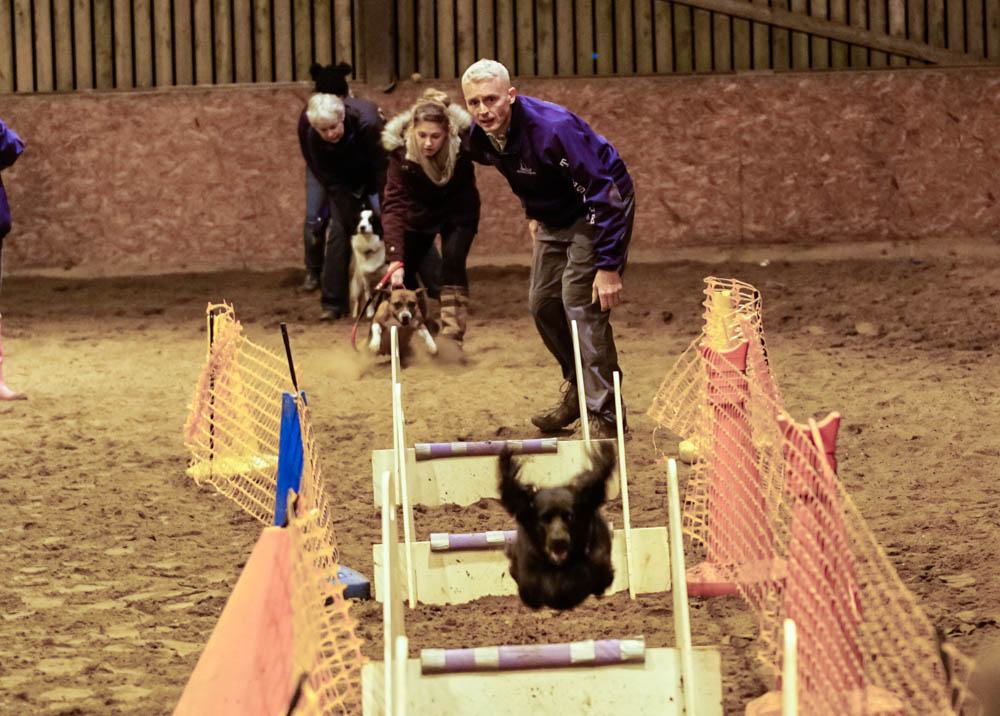Winter Exercise With Teesdale Flyball Club
24/12/2016
Exercising in winter can be tricky. Daylight hours are shorter, conditions are cold, often wet and sometimes icy. We humans tend to take our exercise indoors to gyms and indoor sports clubs. We’ve previously written about exercising your dog in winter, covering activities such as agility and heelwork to music. This time we’re focusing on the complications of winter exercise with the insight of the experienced dog owners at Teesdale Flyball Club.
Weather
I got chatting to young Border Collie Izzy’s owner, Wendy, at the Teesdale Flyball Club about her winter exercise. Wendy explained that their summer exercise routine involved flyball practice at home on an evening with hurdles and a box. In winter however the frosty ground was too hard, which wouldn’t give enough shock absorption for Izzy’s joints. Very wet or icy weather, causing slippery conditions, also prevented flyball practice outdoors. Wendy felt the risk of injury just wasn’t worth it. She was really glad to have the club to attend on Sunday evenings, where Izzy would get her dose of high energy activity on a surface that reduced the possibility of injuring herself.
Making the most of warmer winter days is a good idea for owners of high energy dogs. Hunting out more sheltered locations, such as woodland, where the ground is covered in leaf mould and protected by undergrowth, is another good solution. If it’s possible, heading to the nearest beach provides a great alternative to icy or muddy conditions elsewhere.
Light
Exercising in the dark isn’t nearly as pleasant as exercising in the light, as I’m sure you’ll agree. Finding an activity that takes place indoors in winter is a great solution to this. Teesdale Flyball Club practise at an indoor riding school in the winter months. This provides a vital opportunity for many of their members to give their dogs a long period of sustained activity. Many agility clubs and heelwork to music clubs have indoor facilities. If joining a club doesn’t appeal to you, a floodlit sports ground that allows dogs could be another option. You could also consider altering work hours in winter to allow for a break in the middle of the day. This would free up some precious daylight hours for exercise for both you and your dog.
Food Intake
Despite the extra energy used in staying warm, most dog owners find that food intake decreases in the winter months. Sam, owner of two high energy Border Collie/Springer Spaniel crosses, explained that this is undoubtedly due to reduced exercise from lack of daylight hours. Like Wendy, she was also thankful for the existence of Teesdale Flyball Club. The boundless enthusiasm of Alfie and Otis certainly needed an outlet! Bev, Teesdale Flyball Club’s treasurer, described 30 minutes of flyball as being the equivalent of a two hour walk. For Sam, restricted to walking her dogs in daylight hours, I could see why the club was so vital. Feeding to condition is a really helpful way to ensure your dog gets enough food without overfeeding when their activity levels are lower.
Owners of high energy breeds, like those who attend Flyball, know only too well the difference in behaviour of a well exercised dog and an under exercised one. Whether it is finding an indoor activity or club, looking for alternative locations or changing your routine, looking for solutions to the problems posed by winter exercise can often solve these issues.
With many thanks to the members of the Teesdale Flyball Club for sharing their experiences of winter exercise.



